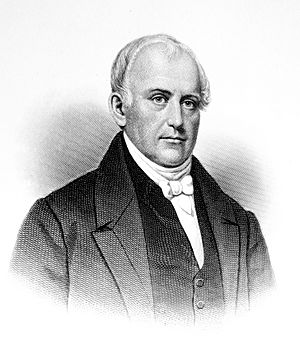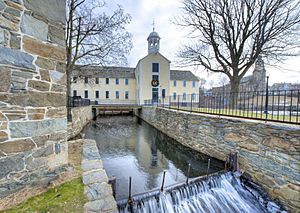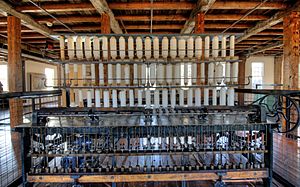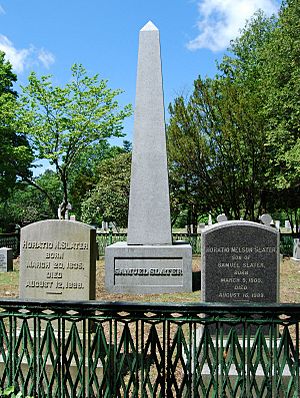Samuel Slater facts for kids
Quick facts for kids
Samuel Slater
|
|
|---|---|
 |
|
| Born | June 9, 1768 Belper, Derbyshire, England
|
| Died | April 21, 1835 (aged 66) Webster, Massachusetts, U.S.
|
| Occupation | Industrialist, author |
| Known for | Bringing the Industrial Revolution to the U.S. from Great Britain |
| Spouse(s) |
Hannah Wilkinson Slater
(m. 1791; Esther Parkinson
(m. 1817) |
| Signature | |
Samuel Slater (born June 9, 1768 – died April 21, 1835) was an important English-American industrialist. He is often called the "Father of the American Industrial Revolution" and the "Father of the American Factory System." In his home country, the United Kingdom, some people called him "Slater the Traitor." This was because he brought British textile technology to the United States. He changed these designs to work well in America.
Slater learned how textile factory machines worked while he was an apprentice in England. He then moved to the U.S. when he was 21. He designed the first textile mills in the U.S. Later, he started his own business with his sons. Eventually, he owned 13 spinning mills. He also created tenant farms and company towns around his mills, like Slatersville, Rhode Island.
Contents
Early Life and Learning
Samuel Slater was born in Belper, England, on June 9, 1768. He was the fifth of eight children in a farming family. He got a basic education. When he was ten, he started working at a cotton mill. This mill used machines called water frames. These machines were first used by Richard Arkwright at a nearby mill.
In 1782, Samuel's father passed away. Samuel then became an apprentice to Jedediah Strutt, the mill owner. Strutt taught him very well. By the time Samuel was 21, he knew everything about how cotton spinning factories worked.
Moving to America
Slater learned that Americans wanted to build similar machines. But he also knew that British law made it illegal to export the designs. So, he memorized as much as he could about the machines. He left for New York in 1789. Some people in his hometown of Belper called him "Slater the Traitor." They felt he was betraying his town by taking this knowledge away.
Building American Factories
In 1789, a businessman named Moses Brown in Rhode Island wanted to run a mill. He had a machine that was supposed to spin yarn, but it didn't work. Slater wrote to Brown and offered his help. Slater quickly saw that the machine was not built correctly. He promised Brown that he could make good yarn, just like they did in England.
In 1790, Slater signed a deal with Brown. Slater would build the water frames and other machines. He would get half of the value of the machines and half of the profits. By December, the mill was running with a few workers. By 1791, Slater had some machines working. In 1793, Slater and Brown opened their first factory in Pawtucket.
Slater understood how to make the machines work together. He also knew how to handle different types of cotton fibers. He made some changes to the designs to fit American needs. This led to the first successful water-powered roller spinning textile mill in America.
After building this mill, Slater used the management ideas he learned in England. He taught workers to become skilled mechanics.
How Slater Managed His Mills
Slater created the "Rhode Island System" for his factories. This system was based on how families lived in New England villages. Children between seven and 12 years old were the first workers in his mill. Slater watched them closely. The first child workers were hired in 1790.
He encouraged whole families to move and work at his mills. He provided houses owned by the company nearby. He also had company stores. He even supported a Sunday School where college students taught the children how to read and write.
Growing the Business
In 1793, Slater built a new mill just for making textiles. He was now partners with Almy and Brown. This mill had 72 spindles for spinning yarn. In 1794, Eli Whitney invented the cotton gin. This machine made it much easier to process cotton. This helped cotton farming grow a lot in the Southern U.S. The mills in New England used this cotton. Slater also brought the idea of Sunday schools from England to his factory in Pawtucket.
In 1798, Samuel Slater left Almy and Brown. He started a new company called Samuel Slater & Company with his father-in-law. They built more mills in Rhode Island, Massachusetts, Connecticut, and New Hampshire.
In 1799, his brother John Slater came from England. John had studied the newest English machines. Samuel put John in charge of a large mill called the White Mill.
By 1810, Slater owned parts of three factories. In 1823, he bought another mill. He also built factories to make the machines used in textile mills. He even partnered with his brother-in-law to make iron for the machines.
Slater had many businesses, and it became hard to manage them all. He preferred to hire only family members as managers. After 1829, he made his sons partners in a new company called Samuel Slater and Sons. His son, Horatio Nelson Slater, made many changes to the family business. He found ways to save money and updated old methods. Slater & Company became one of the biggest manufacturing companies in the United States.
In 1824, workers in the Pawtucket area went on strike. This was the first factory strike in U.S. history. It happened because of the tough working conditions and a planned pay cut for women workers. This strike marked the beginning of a long fight for workers' rights.
Slater also hired people to find families who wanted to work at his mills. He advertised to attract more families.
The Rise of Industry
By 1800, other business owners copied the success of Slater's mill. By 1810, there were about 50 cotton-yarn mills in the U.S. Many of these started because imports from Britain were cut off before the War of 1812. That war made industrialization in New England happen even faster. By the end of the war in 1815, there were 140 cotton factories near Providence. They employed 26,000 people and had 130,000 spinning machines. The American textile industry had truly begun.
Personal Life
In 1791, Slater married Hannah Wilkinson Slater. Hannah invented two-ply thread. In 1793, she became the first American woman to get a patent for her invention. Samuel and Hannah had ten children together, but four of them died when they were babies. Hannah passed away in 1812 after childbirth. Samuel was left to raise their six young children. Samuel and his brother started the Slater family in America.
Slater married again in 1817 to a widow named Esther Parkinson. By this time, his business was very successful. Esther also owned property. So, they signed a pre-nuptial agreement before they got married.
Samuel Slater died on April 21, 1835, in Webster, Massachusetts. He had founded this town in 1832 and named it after his friend, Senator Daniel Webster. When he died, he owned 13 mills. He was worth a lot of money, which would be about $42 million today.
Slater's Legacy and Honors
Slater's first mill is still standing today. It is known as Slater Mill. It is listed on the National Register of Historic Places. It is now a museum that teaches people about Samuel Slater's history. It shows his important contributions to American industry. Slater's original mill in Pawtucket and the town of Slatersville are part of the Blackstone River Valley National Historical Park. This park helps to protect and explain the history of how industry grew in the region.
His important papers are kept at the Harvard Business School's Baker Library.
Images for kids
See also
 In Spanish: Samuel Slater para niños
In Spanish: Samuel Slater para niños




